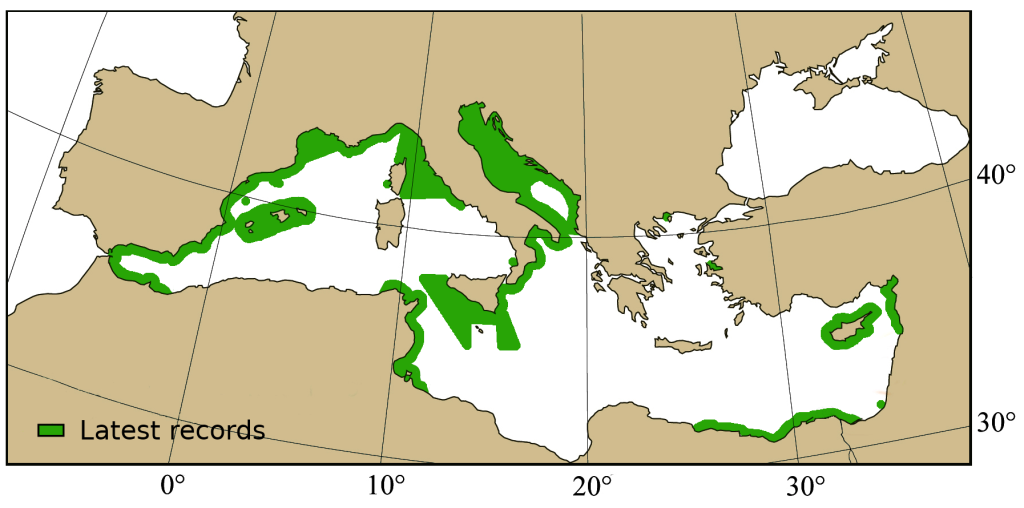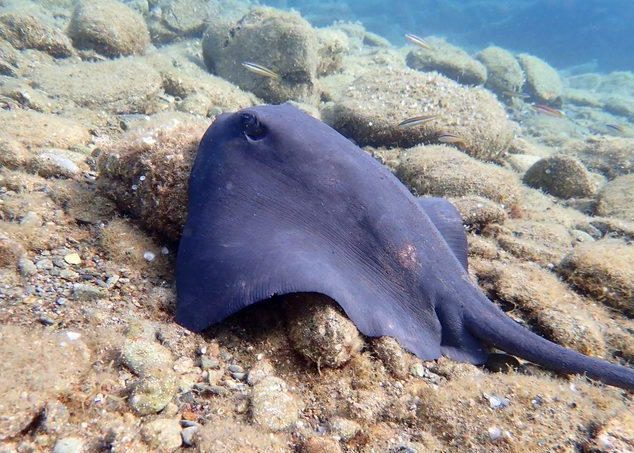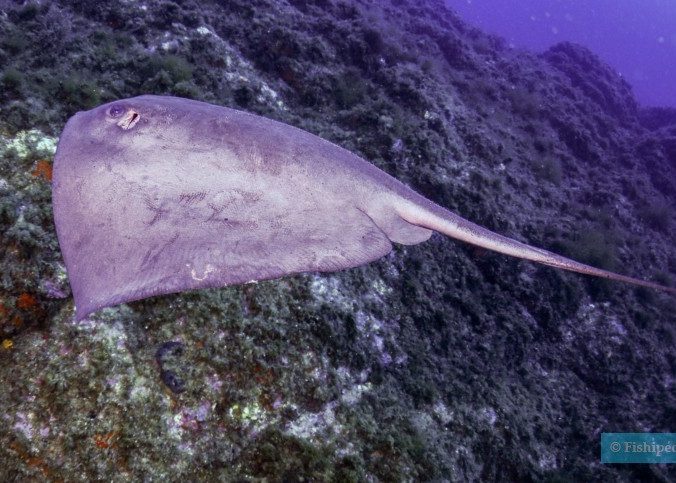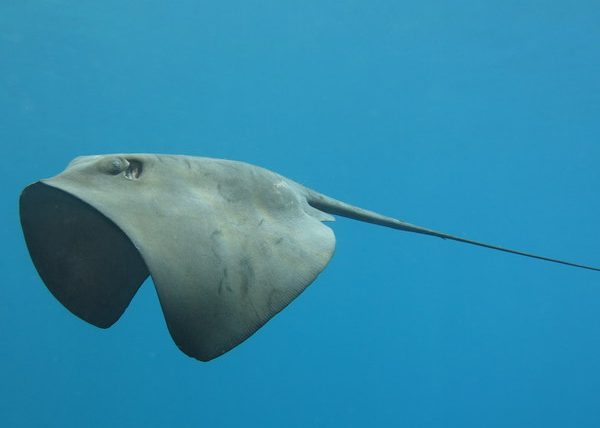Pteroplatytrygon violacea
Common name: Violet Stingray, Common Pelagic Stingray, Blue Stingray
Order: Myliobatiformes
Family: Dasyatidae
Synonyms: Dasyatis violacea, Trygon violacea, Dasyatis atratus, Trygon purpurea
Misidentifications: None.
Short description
Medium-sized species with rounded snout, early triangular disk without thorns and convex margins. 10-12 broad-based papillae. Tail less than twice the body length. Relatively short and narrow fold under the tail tip. Usually one extremely long dart on the tail.
Color: Uniformly purple or dark blue-green dorsally and ventrally.
Measurements:
- Disk width (DW): 60 cm (max 96 cm)
- Total length (TL): up to 130 cm
Swimming pattern: Undulatory locomotion.
Biology / Ecology
Feeds on coelenterates (including medusae), squid, decapod crustaceans and pelagic fish. Poisonous spine on tail.
Reproduction: Viviparous (aplacental viviparity with histotrophy). Size at maturity (DW): 39–50 cm at 3 years female, 35–41 cm at 2 years male. Size at birth (DW): 14-25 cm. Copulation in spring. 2-9 juveniles per litter produced in late summer. Gestation period: 4 months.
Habitat: Epipelagic species in tropical to warm temperate waters. Usually found from surface to 100 m over deep water (max 381 m deep).
Perhaps the only species of stingray that occurs in the pelagic zone.
Distinguishing characteristics
- Whole body from dark purple to dark blue-green color.
- Relatively short and narrow fold under the tail tip.
- 10-12 large papillae.
Myliobatiformes: No caudal and anal fin. Thin tail like a whip.
Dasyatidae: Batoids with depressed bodies.
Distribution
Worldwide: Circumglobal species throughout the tropical and temperate oceans. Absent from Black Sea.
Mediterranean: Present in the Mediterranean.
- Occurrence: Abundant.
- Latest records: Cyprus (2018-2022), Tunisia (2017), Izmir & Iskenderun bay – Turkey (2016), Adriatic Sea (2015), Spain & Balearic Sea (2015), Gulf of Lion (2015), Ligurian, northern and central Tyrrhenian Seas – Italy (2015), Southern Sicily (2015), Southern Italy (2011), Egypt (2010), Slovenia (2004).

Any recent observation not on the map?
Contact us!
Conservation
Threats: Caught as bycatch in drifting longliners for tunas, billfishes, and pelagic sharks. Mostly discarded because of its low or no commercial value. Retained and utilized in some areas for its meat and sometimes cartilage.
Protection level:
- Mediterranean: Least Concern (IUCN 2016, last assessment: 2016)
- Global: Least Concern (IUCN 2019, last assessment: 2018)
Key references
- Carpentieri P., Nastasi A., Sessa M., Srour A. 2021. Incidental catch of vulnerable species in Mediterranean and Black Sea fisheries – A review. General Fisheries Commission for the Mediterranean – Studies and Reviews 101: I-317.
- Follesa M. C., Marongiu M. F., Zupa W., Bellodi A., Cau A., Cannas R., Colloca F., Djurovic M., Isajlovic I., Jadaud A., Manfredi C., Mulas A., Peristeraki P., Porcu C., Ramirez-Amaro S., Salmerón Jiménez F., Serena F., Sion L., Thasitis I., Cau A., Carbonara P. 2019. Spatial variability of Chondrichthyes in the northern Mediterranean. Scientia Marina 83(S1) : 81-100.
- Geraci M. L., Ragonese S., Scannella D., Falsone F., Gancitano V., Mifsud J., Gambin M., Said A., Vitale S. 2021. Batoid abundances, spatial distribution, and life history traits in the Strait of Sicily (Central Mediterranean Sea): Bridging a knowledge gap through three decades of survey. Animals 11(8): 2189.
- Giovos I., Serena F., Katsada D., Anastasiadis A., Barash A., Charilaou C., Hall-Spencer J.M.,Crocetta F.,Kaminas A., Kletou D, Maximiadi M., Minasidis V., Moutopoulos D.K., Aga-Spyridopoulou R.N., Thasitis I., Kleitou P. 2021. Integrating literature, biodiversity databases, and citizen-science to reconstruct the checklist of Chondrichthyans in Cyprus (Eastern Mediterranean Sea). Fishes 6(3): 24.
- O’Keefe M., Bengil EG., Palmer JL, Beton D, Çağlar Ç., Godley B.J, Özkan M., Snape R.T.E., Broderick A.C. 2023. Diversity and distribution of elasmobranchs in the coastal waters of Cyprus: using bycatch data to inform management and conservation. Front. Mar. Sci. 10: 1181437.
- Ragheb E., Hasan M.W.A. 2021. First record of Pteroplatytrygon violacea (Bonaparte, 1832) with annotation of cartilaginous fishes by-catch by gill nets (Egyptian Mediterranean). The Egyptian Journal of Aquatic Research 47(4): 387-392.
- Ramírez-Amaro S., Ordines F., Esteban A., García C., Guijarro B., Salmerón F., Terrasa B., Massutí E. 2020. The diversity of recent trends for chondrichthyans in the Mediterranean reflects fishing exploitation and a potential evolutionary pressure towards early maturation. Scientific Reports 10(1): 1-18.



